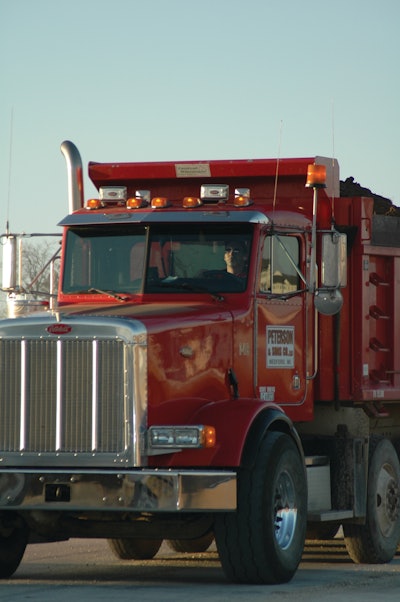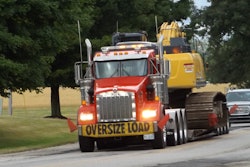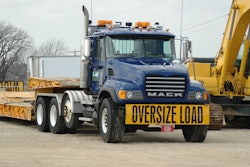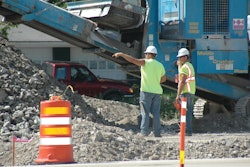
A true construction-business axiom: just getting to and from the jobsite is half the battle. When your crew rolls out of the yard, you need them thinking of safety at every step along the way, particularly while driving.
We’ll give you credit ahead of time for doing all the usual stuff, such as having a seat-belt policy, doing pre-trip inspections, checking load securement, and the like. Here are some proven defensive-driving tips for contractor fleets to review at your next safety meeting:
- Drivers must maintain a safe following distance, at all speeds and in all locations. Low speed rear end bumps are endemic at stoplights. Risk escalates with a loaded 10-wheel dump or lowboy carrying a machine. The rig has a lot of momentum, even at low speed. Always allow ample stopping distances. Remain well back from whatever is ahead of you. When stuck in a line of slow moving vehicles, such as at a congested intersection, allow vehicles ahead of you to open up a gap before you speed up. Sudden stops by negligent drivers are common.
- Protect your rear! Other drivers will quickly become impatient with slow moving vehicles ahead of them. They will try to cut out and zoom around your rig, as if they're all driving the hot cars in those idiotic TV commercials. Your driver needs to position themselves defensively in traffic to avoid becoming an obstacle to four-wheelers. Use headlights, signals, strobe lights and brake lights to warn or alert other drivers. Adding a warning decal advising ‘Stay Back’ or ‘Do No Tailgate’ on the rear can help a bit.
- Choose your battles. Whenever possible, avoid routing a rig through congested areas. Move the rig in early morning or wait until rush hour is over. The extra bucks you spend on drivers' time is nothing compared with the cost of a claim. This is called "route planning" and we should be doing more of it. Interstate highways are the safest routes. Two-lane, undivided highways are at the opposite extreme. If you can avoid the two-lane, by all means, do it. And be sure to allow sufficient time for a driver to make the run. Do not encourage them to push it. This should also apply to trucking contractors working for you.
- Clean the rig before it moves off site. We’ll give you credit for loading it safely and securing it properly when it leaves your yard, but rigs leaving a muddy work site are a different story. Operators must ensure the machine is as clean as possible before it goes on the ramps. Provide the tools and hardware to make this happen. Brooms, spades, trowels, pressure washers, etc. should be standard hardware when transporting machines. Flat bed and low boy drivers need to take extra care to clean the tracks, tire treads, beds, decks, ramps and edges before getting on the road. Bonus Tip: develop a simple checklist of items to cover when loading/unloading equipment on trailers. A lot of accidents occur during load/unload. Cover your bet with a tight protocol of actions and inspection.
- Watch what is in front of you when stopped. Specifically, right under your nose. Small cars, cyclists, pedestrians, flaggers may be obscured by the hood profile of the rig. This is a common danger in the trucking industry. School busses are now being equipped with a crossing gate attached to the front bumper to keep kids out of the blind spot. Anteater profile hoods and wide angle mirrors can help. On large trucks and tractors, drivers need to continually be aware of this blind spot. If they can’t be sure it’s clear, get out and look, or have a spotter check your clearances.
- Park defensively! Drivers need to THINK before parking. Taking a rig into a Taco Bell drive thru is asking for trouble. Direct and remind your driver to park well away from other vehicles. When safely parked, it is good practice to place a cone at rear, forcing the driver to check their perimeter before moving. Defensive parking also includes parking in such a way as to avoid the need to back up. Backing a rig without a spotter, as we all know, is basically asking for an insurance claim. 12 Steps to Backing Equipment Safely
- Lights on at all times. The human eye is light seeking. Take advantage of this and make it easier for other drivers to see you. Most drivers are essentially lazy, causing them to barely peep out the corners of their eye to see approaching traffic, such as at intersections. Daytime running lights help identify your rig under all lighting conditions, including broad daylight. Not convinced? The number one statement made on serious crash reports is “I never saw them.” Your cheapest insurance policy is to pull the light switch.
- Avoid night time driving. The statistics are not favorable. About 30% of all driving is done at night, but darkness accompanies more than 60% of fatal crashes. Impaired, fatigued, disoriented, distracted, take your pick, there are a host of ills accompanying night time drivers. If you can avoid it, travel in daylight. Keep in mind, the risk of encountering a drunk driver is much greater after midnight.
- Worst day of the week for auto accidents? You guessed it: Saturday. By an appreciable factor. Fortunately it’s not a regular workday, but keep it in mind. Combine this with No. 8, and you should make sure everything stays parked after 9 p.m. Saturday.
- Drivers’ attitude trumps traffic laws. Road-rage incidents are increasingly common. Your drivers should be showing patience and courtesy all along the way. And they should ALWAYS leave themselves an "out;" that is, avoid being boxed in by other traffic. This sacrifices driver's options to protect themselves. Unfortunately, other drivers will often view your rig as an impediment to their speedy progress. Your driver should try to accommodate for this with defensive positioning in traffic situations. And please, NO TEXTING or distractions in the cab! Keep Your Employees Safe with a Texting Ban
If you do even some of the above, your odds of avoiding accidents will improve. A smart manager will build defensive driving into their overall safety program, along with all the other occupational safety requirements. Your safety record, and your auto insurance rates, will benefit in the long run.
John Meola, is a construction safety specialist with the Louis Berger Group based in Richmond, Va. Contact: [email protected]



















